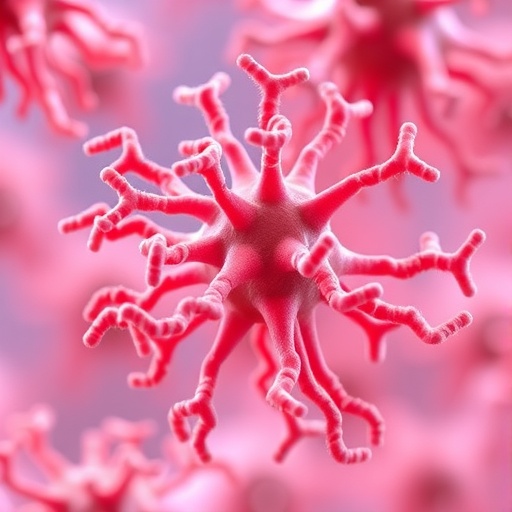In an era marked by the mounting challenge of antibiotic-resistant bacteria, the hunt for novel antimicrobials has never been more urgent. While traditional sources of antibiotics have predominantly focused on bacteria and fungi, a groundbreaking study now casts a spotlight on an ancient and largely overlooked domain of life: archaea. These single-celled microorganisms, distinct from bacteria and eukaryotes, harbor untapped chemical weaponry that could revolutionize our approach to antimicrobial treatments.
Researchers led by Tobias Warnecke at the University of Oxford and the MRC Laboratory of Medical Sciences in the United Kingdom have unveiled a remarkable repertoire of antimicrobial proteins produced by archaea. These proteins have the unique ability to cleave peptidoglycan, a crucial component of bacterial cell walls. This enzymatic activity disrupts bacterial integrity, effectively killing the cells and opening a promising avenue for the development of new antibacterial agents.
Archaea, often celebrated for their extremophilic lifestyles in environments such as salt lakes, hot springs, and acidic waters, are vastly understudied in the context of microbial warfare. Their natural habitats teem with bacterial neighbors, necessitating evolved mechanisms of competition and survival. Yet, until now, the molecular arsenal of archaea has remained a mystery. By exploring the genomes of over 3,700 archaeal species, the team identified genes encoding potential peptidoglycan-hydrolyzing enzymes, indicating a widespread and diverse presence of these bacterial-killing proteins among archaea.
Intriguingly, only about 5% of the surveyed archaeal species possess these proteins, and some species contain multiple types, suggesting a complex and potent antimicrobial toolkit. Laboratory experiments confirmed that these proteins, when isolated and tested, successfully killed various bacteria, providing direct evidence of their bactericidal function. Structural analyses further revealed that many of these enzymes are secreted outside the archaeal cell, with some archaea potentially capable of delivering these lethal proteins through sophisticated injection systems akin to molecular syringes.
The implications of this discovery are profound. The microbial world is a dynamic arena of chemical combat, where organisms vye for dominance and survival. Our conventional antibiotics trace their origins to bacterial and fungal metabolites, but archaea represent a distinct domain whose contributions to this chemical warfare have remained unexplored. Unlocking their arsenal presents a tantalizing prospect for novel antimicrobial drug discovery, especially vital given the global rise in antibiotic-resistant pathogens.
Delving deeper, the research team noted that peptidoglycan-hydrolyzing proteins are just one facet of archaeal antimicrobials. Archaeal species likely possess a broader spectrum of antibacterial molecules and strategies yet to be characterized. Understanding the full extent of their antimicrobial capabilities requires further investigation into the biochemical pathways and ecological roles archaea play in microbial consortia.
Dr. Warnecke emphasizes the novelty of this revelation: “Archaea are their own Domain of Life, different from bacteria and eukaryotes. We know very little about their social lives or how they interact with the ubiquitous bacteria that surround them. Our work sheds new light on these interactions, uncovering a darker and more competitive aspect of archaeal existence.”
First author Romain Strock adds a perspective that challenges traditional views of archaea as mere extremophiles or cooperative partners: “Archaea are often depicted as lone extremophiles or syntrophic partners. Our research depicts another, darker side to their social life, highlighting their role as microbial warriors.”
Beyond its immediate scientific impact, this study contributes a fresh conceptual framework for microbiology and drug development. By expanding the search for antimicrobial agents into archaea, it opens new horizons for combating antibiotic-resistant bacteria, a pressing public health concern worldwide. Harnessing archaeal enzymes might pave the way for innovative therapies that circumvent existing mechanisms of bacterial resistance.
Moreover, the structural and functional insights gleaned from these proteins provide valuable blueprints for synthetic biology. Designing engineered molecules modeled after archaeal enzymes could enhance specificity and potency against pathogenic bacteria. Additionally, deciphering the injection machinery that some archaea employ could inspire novel delivery systems for therapeutics.
The quest to understand archaeal antimicrobials also bridges evolutionary biology with medical science, offering clues about the ancient origins of microbial competition. As archaea diverged early in the tree of life, their molecular strategies may reflect primordial modes of inter-microbial conflict, adding depth to our understanding of microbial ecology and evolution.
While this discovery marks a significant leap, it also spotlights the vast unknown that remains. The diversity of archaea, with over 20,000 species identified and many more yet to be characterized, suggests a treasure trove of natural products awaiting discovery. Unlocking these molecular secrets could catalyze a new era of antimicrobial innovation.
In summary, this pioneering research transcends traditional microbiological boundaries, revealing that archaea, far from being passive environmental dwellers, are active participants in microbial warfare. Their peptidoglycan-cutting proteins exemplify an enigmatic and powerful antimicrobial resource, inviting scientists to explore a novel frontier in the fight against bacterial pathogens.
Subject of Research: Cells
Article Title: Archaea produce peptidoglycan hydrolases that kill bacteria
News Publication Date: August 14, 2025
Web References: http://dx.doi.org/10.1371/journal.pbio.3003235
References: Strock R, Soo VW, Misson P, Roumelioti G, Shliaha PV, Hocher A, et al. (2025) Archaea produce peptidoglycan hydrolases that kill bacteria. PLoS Biol 23(8): e3003235.
Image Credits: Aida Sanchez-Ricol (Warnecke lab) (CC-BY 4.0)
Keywords: archaea, peptidoglycan hydrolases, antimicrobials, antibiotic resistance, microbial warfare, microbial competition, bacterial cell wall, molecular injection system, microbial ecology, novel antibiotics




